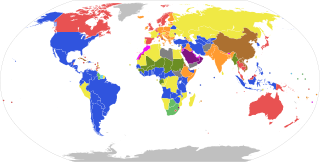
A semi-presidential republic, or dual executive republic, is a republic in which a president exists alongside a prime minister and a cabinet, with the latter two being responsible to the legislature of the state. It differs from a parliamentary republic in that it has an executive president independent of the legislature; and from the presidential system in that the cabinet, although named by the president, is responsible to the legislature, which may force the cabinet to resign through a motion of no confidence.

Sushilkumar Sambhaji Shinde is an Indian politician from the state of Maharashtra. He was the Minister of Home Affairs, Minister of Power in the Manmohan Singh government, and the Leader of the House in Lok Sabha until 26 May 2014. He previously served as the Chief Minister of Maharashtra from 18 January 2003 to 4 November 2004.

Vasantrao Banduji Patil was an Indian politician from Sangli, Maharashtra. He was known as the first modern Maratha strongman and first mass leader in Maharashtrian politics.

Jayant Rajaram Patil is an Indian politician from the state of Maharashtra. He has been representing Islampur in the Maharashtra Legislative Assembly for more than 3 decades. He was the Cabinet Minister of the Water Resources Department in Uddhav Thackeray ministry. Previously he has been the Rural Development Minister, the Finance Minister and the Home Minister of Maharashtra.

Dr. Padmasinha Bajirao Patil is a former member of 15th Lok Sabha, the lower house of Parliament of India.

Vijaysinh Shankarao Mohite-Patil is a politician from the Nationalist Congress Party and Member of Parliament (MP) for Madha in Maharashtra since the 2014 general election till the 2019 general election. He is member of Nationalist Congress Party.
Although a parliamentary democracy, Indian politics has increasingly become dynastic, possibly due to the absence of a party organization, independent civil society associations that mobilize support for the party, and centralized financing of elections. Family members have also led the Congress party for most of the period since 1978 when Indira Gandhi floated the then Congress(I) faction of the party. It also is fairly common in many political parties in Maharashtra. The dynastic phenomenon is seen from national level down to district level and even village level.The three-tier structure of Panchayati Raj established in the 1960s also helped to create and consolidate the dynastic phenomenon in rural areas. Apart from government,political families also control cooperative institutions, mainly cooperative sugar factories,district cooperative banks in the state, and since the 1980s private for profit colleges. The ruling Bharatiya Janata Party also features several senior leaders who are dynasts. In Maharashtra, the NCP has particularly high level of dynasticism.

Chandrakant Bacchu Patil is an Indian politician and the Higher and technical education minister of Maharashtra state in the present Government of Maharashtra. Chandrakant Patil was the Maharashtra state President of Bharatiya Janata Party (BJP).
Sudhakarrao Naik was sworn in as Chief Minister of Maharashtra on 25 June 1991, on resignation of his predecessor Sharad Pawar. The ministry served until February 1993, when Naik resigned due to his inability to handle the 1993 Bombay riots, and was replaced by Pawar.
After securing a majority in the 1990 Maharashtra legislative elections, the incumbent Chief Minister Sharad Pawar was re-appointed on 4 March 1990. Pawar formed his third ministry, consisting of 15 cabinet ministers and 6 ministers of state. The cabinet continued until June 1991, when Pawar was replaced by Sudhakarrao Naik.
On resignation of Shankarrao Chavan on 26 June 1988, Sharad Pawar was appointed Chief Minister of Maharashtra for the second time. Pawar formed his second ministry, which continued in office until legislative elections in 1990.
Shankarrao Chavan was sworn in as Chief Minister of Maharashtra for the second time in March 1986, on resignation of his predecessor, Shivajirao Patil Nilangekar. Chavan's cabinet served until his resignation on 26 June 1988, and subsequent replacement by Sharad Pawar's ministry.
Shivajirao Patil Nilangekar became the chief minister of Maharashtra in June 1985, on resignation of Vasantdada Patil. He formed a 11-member ministry that served for less than a year until Nilangekar's resignation amidst fraud allegations.
After the Congress (I) party secured a majority in 1980 Maharashtra legislative elections, A. R. Antulay was appointed Chief Minister. Antulay's administration continued until January 1982, when he resigned amidst corruption allegations. Till date, Antulay remains the state's only Muslim chief minister.
Babasaheb Bhosale was appointed as the Chief Minister of Maharashtra on resignation of A. R. Antulay in January 1982. Bhosale had been law, labour, and transport minister in Antulay's cabinet. Bhosale's government served for about a year, until he was replaced by Vasantdada Patil in February 1983.
Vasantdada Patil was sworn in as Maharashtra chief minister for the third time in February 1983, on resignation of Babasaheb Bhosale. The third Patil ministry continued until 1985 legislative elections, after which Patil continued as chief minister with his fourth ministry.
In the aftermath of 1978 Maharashtra legislative elections, Vasantdada Patil of the Indian National Congress(U) was appointed Chief Minister. A coalition government, it consisted of members from Congress(Urs) and Congress (I), including Deputy Chief Minister Nashikrao Tirpude.
Vasantdada Patil became the Chief Minister of Maharashtra for the first time on 17 April 1977, replacing Shankarrao Chavan. The government continued until the 1978 legislative elections, after which Patil continued with his second ministry.
Shankarrao Chavan was appointed as Chief Minister of Maharashtra for the first time on 21 February 1975, replacing Vasantrao Naik. His first ministry lasted till 16 April 1977, and was succeeded by Vasantdada Patil's ministry.
Following 1972 Maharashtra Legislative Assembly election, incumbent chief minister Vasantrao Naik was re-appointed, and he formed his third government on 14 March 1972. This was to be Naik's last government which served until 20 February 1975.







